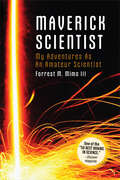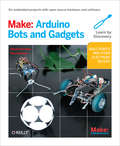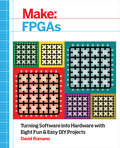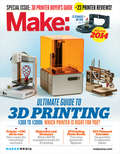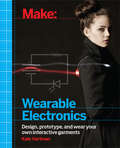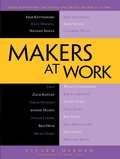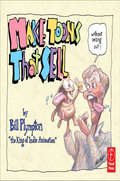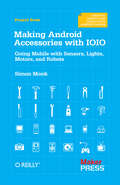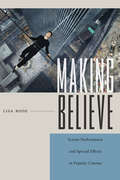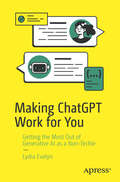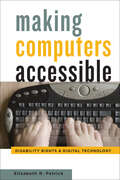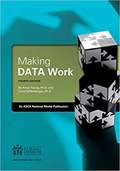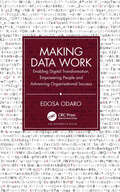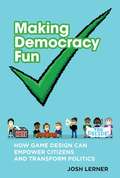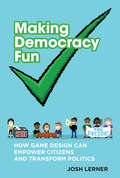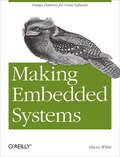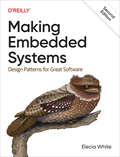- Table View
- List View
Make: My Adventures as an Amateur Scientist
by Forrest M. MimsMaverick Scientist is the memoir of Forrest Mims, who forged a distinguished scientific career despite having no academic training in science. Named one of the "50 Best Brains in Science" by Discover magazine, Forrest shares what sparked his childhood curiosity and relates a lifetime of improbable, dramatic, and occasionally outright dangerous experiences in the world of science.At thirteen he invented a new method of rocket control. At seventeen he designed and built an analog computer that could translate Russian into English and that the Smithsonian collected as an example of an early hobby computer. While majoring in government at Texas A&M University, Forrest created a hand-held, radar-like device to help guide the blind. And during his military service, he had to be given special clearance to do top secret laser research at the Air Force Weapons Lab. Why? Because while he lacked the required engineering degree, they wanted his outside-the-box thinking on the project.He went on to co-found MITS, Inc., producer of the first commercially successful personal computer, wrote a series of electronics books for Radio Shack that sold more than seven million copies, and designed the music synthesizer circuit that became known as the infamous Atari Punk Console. All this came before he started consulting for NASA's Goddard Space Flight Center, and NOAA's famous Mauna Loa Observatory, and earning the prestigious Rolex Award.This intimate portrait of a self-made scientist shares a revelatory look inside the scientific community, and tells the story of a lifelong learner who stood by his convictions even when pressured by the establishment to get in line with conventional wisdom. With dozens of personal photos and illustrations, Maverick Scientist serves as proof that to be a scientist, you simply need to do science.
Make: Projects for extending MINDSTORMS NXT with open-source electronics
by Adam Wolf John Baichtal Matthew BecklerMake amazing robots and gadgets with two of today’s hottest DIY technologies. With this easy-to-follow guide, you’ll learn how to build devices with Lego Mindstorms NXT 2.0, the Arduino prototyping platform, and some add-on components to bridge the two. Mindstorms alone lets you create incredible gadgets. Bring in Arduino for some jaw-dropping functionality—and open a whole new world of possibilities.Build a drink dispenser, music synthesizer, wireless lamp, and moreEach fun and fascinating project includes step-by-step instructions and clear illustrations to guide you through the process. Learn how to set up an Arduino programming environment, download the sketches and libraries you need, and work with Arduino’s language for non-programmers. It’s a perfect book for students, teachers, hobbyists, makers, hackers, and kids of all ages.Build a Drawbot that roams around and traces its path with a marker penConstruct an analog Mindstorms clock with hands that display the correct timeCreate a machine that mixes a glass of chocolate milk at the touch of a buttonMake a Gripperbot rolling robotic arm that you control wirelessly with Arduinos mounted on your armsExplore electronic music by building a guitar-shaped Lego synthesizerBuild a Lego lamp with on/off and dimmer switches that you control with a smartphone applicationJump feet first into the world of electronics, from learning Ohm’s Law to working with basic componentsYou'll need the Bricktronics shield created for this book by Open Source Hardware kit maker Wayne and Layne, or you can build a breadboarded equivalent (see Chapter 10) for about $25 in parts.
Make: Six Embedded Projects with Open Source Hardware and Software
by Tero Karvinen Kimmo KarvinenWant to build your own robots, turn your ideas into prototypes, control devices with a computer, or make your own cell phone applications? It's a snap with this book and the Arduino open source electronic prototyping platform. Get started with six fun projects and achieve impressive results quickly.Gain the know-how and experience to invent your own cool gadgets.With Arduino, building your own embedded gadgets is easy, even for beginners. Embedded systems are everywhere—inside cars, children’s toys, and mobile phones. This book will teach you the basics of embedded systems and help you build your first gadget in just a few days. Each learn-as-you-build project that follows will add to your knowledge and skills.Experiment with Arduino, the popular microcontroller boardBuild robots and electronic projects with easy-to-follow instructionsTurn your ideas into working physical prototypesUse Android phones as remote controls in your projectsWork with an uncomplicated programming language created for artists, designers, and hobbyistsGet everyone involved, with projects that even beginners can build
Make: The Essential Guide to 3D Printers
by Anna Kaziunas FranceThe 3D printing revolution is well upon us, with new machines appearing at an amazing rate. With the abundance of information and options out there, how are makers to choose the 3D printer that's right for them? MAKE is here to help, with our Ultimate Guide to 3D Printing. With articles about techniques, freely available CAD packages, and comparisons of printers that are on the market, this book makes it easy to understand this complex and constantly-shifting topic.Based on articles and projects from MAKE's print and online publications, this book arms you with everything you need to know to understand the exciting but sometimes confusing world of 3D Printing.
Make: Turning Software into Hardware with Eight Fun and Easy DIY Projects
by David RomanoWhat if you could use software to design hardware? Not just any hardware--imagine specifying the behavior of a complex parallel computer, sending it to a chip, and having it run on that chip--all without any manufacturing? With Field-Programmable Gate Arrays (FPGAs), you can design such a machine with your mouse and keyboard. When you deploy it to the FPGA, it immediately takes on the behavior that you defined. Want to create something that behaves like a display driver integrated circuit? How about a CPU with an instruction set you dreamed up? Or your very own Bitcoin miner You can do all this with FPGAs. Because you're not writing programs--rather, you're designing a chip whose sole purpose is to do what you tell it--it's faster than anything you can do in code. With Make: FPGAs, you'll learn how to break down problems into something that can be solved on an FPGA, design the logic that will run on your FPGA, and hook up electronic components to create finished projects.
Make: Ultimate Guide to 3D Printing 2014
by Mark FrauenfelderIt’s 3D Printing: The Next Generation! The technology’s improving, prices are dropping,new models are hitting the market, and 3D printers are appearing on desktops, workbenches, lab shelves, and kitchen tables all over the world. Not only are we seeing better, faster, and cheaper 3D printers, we’re also seeing new printing materials, easier-to-use design software, powerful scanning technology, and the rise of an entire ecosystem of 3D peripherals and services that support 3D printing technology.Make’s second annual 3D Printing Guide is once again your go-to resource for discovering the latest information in this fast-changing field of printers, software, projects, and accessories. Inside, you'll find up-to-date reviews on the latest in 3D printing technology, feature and model comparisons, tutorials and stories about 3d printing, and some of the coolest 3d printed objects out there.
Make: Wearable Electronics
by Kate HartmanWhat if your clothing could change color to complement your skin tone, respond to your racing heartbeat, or connect you with a loved one from afar? Welcome to the world of shoes that can dynamically shift your height, jackets that display when the next bus is coming, and neckties that can nudge your business partner from across the room. Whether it be for fashion, function, or human connectedness, wearable electronics can be used to design interactive systems that are intimate and engaging. Make: Wearable Electronics is intended for those with an interest in physical computing who are looking to create interfaces or systems that live on the body. Perfect for makers new to wearable tech, this book introduces you to the tools, materials, and techniques for creating interactive electronic circuits and embedding them in clothing and other things you can wear. Each chapter features experiments to get you comfortable with the technology and then invites you to build upon that knowledge with your own projects. Fully illustrated with step-by-step instructions and images of amazing creations made by artists and professional designers, this book offers a concrete understanding of electronic circuits and how you can use them to bring your wearable projects from concept to prototype.
Makers at Work
by Steven OsbornWhat do you get when you combine an electronics hobbyist, hacker, garage mechanic, kitchen table inventor, tinkerer, and entrepreneur? A "maker," of course. Playful and creative, makers are--through expertise and experimentation--creating art, products, and processes that change the way we think and interact with the world. As you''ll see from the 21 interviews in Makers at Work, inquisitive makers are just as apt to pick up a laser cutter or an Arduino as a wrench to fashion something new. For example, you''ll meet Jeri Ellsworth, who might provide a video lecture on magnetic logic one day and a tutorial on welding a roll bar on a stock car the next. You''ll also meet Eben Upton, who put cheap, powerful computing in the hands of everyone with the Raspberry Π Becky Stern, who jazzes up clothing with sensors and LEDs; and bunnie Huang, who knows the ins and outs of the Shenzhen, China, electronics parts markets as well as anyone. As all the interviews in Makers at Work show, makers have something in common: reverence for our technical past coupled with an aversion to convention. If they can''t invent new processes or products, it''s simply not worth doing. Crazy as foxes, makers--working in the spirit of Tesla, Wozniak, Edison, Gates, Musk and many others--can bring sophisticated products to the people or to the market as fast or faster than large corporations. And they are not just enabling new technologies and devices--they are changing the way these devices are funded, manufactured, assembled, and delivered. Makers at Work puts a spotlight on the maker mindset and motivation of those who are reinventing the world one object or idea at a time. You will: Meet the individuals who define what it means to be a maker. Learn about the tools and technologies driving the new industrial revolution. Discover ways to scale your weekend project into a profitable business. See how others have used to crowdfunding to make their visions a reality. Learn how open-source hardware and software is enabling whole new categories of products by removing barriers of entry for inventors. The new masters of the "Makerverse" ask two questions: Can it be done? Is it fun? As these interviews will show, the answer to both questions is, "Let''s find out. " What you''ll learn You will: Learn about 3d printing and how it is changing manufacturing. Discover new software tools for designing things on your own. Learn how to source parts, code, or ideas for your creations. Meet maker pioneers who helped open up a new world, and makers who have used crowdfunding to support their efforts. Uncover recipes for success or failure when bringing physical products to market. Learn ways to scale your weekend project into a profitable business from experienced entrepreneurs. Learn how open-source hardware and software is enabling new classes of products by removing the barrier of entry for inventors. Open your mind to new ideas, methods, things, and possibilities. Who this book is for This book is for anyone with an independent spirit, creative bent, or natural curiosity who believes you can create whatever your mind can conceive and wants to see how others have done just that. Table of Contents Erik Kettenburg, Founder, Digistump David Merrill, Cofounder, Sifteo Nathan Seidle, CEO, SparkFun Electronics Laen, Founder, OSH Park Zach Kaplan, Founder and CEO, Inventables Emile Petrone, Founder, Tindie bunnie Huang, Founder, bunnie studios Natan Linder, Founder, FormLabs Ben Heck, Host, The Ben Heck Show Becky Stern, Director of Wearable Electronics, Adafruit Industries Eric Stackpole, Cofounder, OpenROV Eben Upton, Founder, Raspberry Pi Foundation Catarina Mota, Founder, OpenMaterials. org Ward Cunningham, Inventor, Wiki Jeri Ellsworth, Founder, Technical Illusions Sylvia Todd, Maker, Sylvia''s Super Awesome Maker Show! Dave Jones, Host, EEVBlog Bre Pettis, CEO, MakerBot Eric Migicovsky, CEO, Pebble Technology Ian Lesnet, Slashdot Troll, Dangerous Prototypes Massimo Banzi, Cofounder, Arduino
Making 'Toons That Sell Without Selling Out: The Bill Plympton Guide to Independent Animation Success
by Bill PlymptonLearn the secrets behind independent animation from the "The King of Independent Animation" - Academy Award-nominated Bill Plympton. This living legend breaks down how to make a career outside of the world of corporate animation - and without compromise. Learn time-saving techniques, the secrets to good storytelling, and the business-side of short and feature-length animation films.
Making Android Accessories with IOIO
by Simon MonkCreate your own electronic devices with the popular IOIO ("yoyo") board, and control them with your Android phone or tablet. With this concise guide, you'll get started by building four example projects--after that, the possibilities for making your own fun and creative accessories with Android and IOIO are endless. To build Android/IOIO devices, you write the program on your computer, transfer it to your Android, and then communicate with the IOIO via a USB or Bluetooth connection. The IOIO board translates the program into action. This book provides the source code and step-by-step instructions you need to build the example projects. All you have to supply is the hardware. Learn your way around the IOIO and discover how it interacts with your Android Build an intruder alarm that sends a text message when it detects movement Make a temperature sensing device that logs readings on your Android Create a multicolor LED matrix that displays a Space Invader animation Build an IOIO-powered surveillance rover that you control with your Android Get the software and hardware requirements for creating your own Android/IOIO accessories
Making Android Accessories with IOIO: Going Mobile with Sensors, Lights, Motors, and Robots
by Simon MonkCreate your own electronic devices with the popular IOIO ("yoyo") board, and control them with your Android phone or tablet. With this concise guide, you’ll get started by building four example projects—after that, the possibilities for making your own fun and creative accessories with Android and IOIO are endless.To build Android/IOIO devices, you write the program on your computer, transfer it to your Android, and then communicate with the IOIO via a USB or Bluetooth connection. The IOIO board translates the program into action. This book provides the source code and step-by-step instructions you need to build the example projects. All you have to supply is the hardware.Learn your way around the IOIO and discover how it interacts with your AndroidBuild an intruder alarm that sends a text message when it detects movementMake a temperature sensing device that logs readings on your AndroidCreate a multicolor LED matrix that displays a Space Invader animationBuild an IOIO-powered surveillance rover that you control with your AndroidGet the software and hardware requirements for creating your own Android/IOIO accessories
Making Believe: Screen Performance and Special Effects in Popular Cinema
by Lisa BodeIn the past twenty years, we have seen the rise of digital effects cinema in which the human performer is entangled with animation, collaged with other performers, or inserted into perilous or fantastic situations and scenery. Making Believe sheds new light on these developments by historicizing screen performance within the context of visual and special effects cinema and technological change in Hollywood filmmaking, through the silent, early sound, and current digital eras. Making Believe incorporates North American film reviews and editorials, actor and crew interviews, trade and fan magazine commentary, actor training manuals, and film production publicity materials to discuss the shifts in screen acting practice and philosophy around transfiguring makeup, doubles, motion capture, and acting to absent places or characters. Along the way it considers how performers and visual and special effects crew work together, and struggle with the industry, critics, and each other to define the aesthetic value of their work, in an industrial system of technological reproduction. Bode opens our eyes to the performing illusions we love and the tensions we experience in wanting to believe in spite of our knowledge that it is all make believe in the end.
Making Buying Decisions: Using the Computer as a Tool (2nd edition)
by Richard ClodfelterDesigned for use in a buying course with a heavy math emphasis, activities involve the student solving merchandising problems by using computerized spreadsheets. This manual is designed to accompany the text Retail Buying, 2nd edition, also by Richard Clodfelter.
Making ChatGPT Work for You: Getting the Most Out of Generative AI as a Non-Techie
by Lydia EvelynGain a clear and practical understanding of ChatGPT, the cutting-edge language model that is revolutionizing how we create content, analyse data, and communicate. This book will be your essential companion for navigating the rapidly-evolving world of generative AI. You&’ll explore an army of diverse features boasted by ChatGPT, including web searching, analysing images, PDFs and other file types, image creation with ChatGPT&’s DALL-E, and video generation with ChatGPT&’s Sora. Highlighted by over 100 prompts, this book boasts step-by-step guides on how to use ChatGPT for a variety of tasks such as thesis writing, creating a sales report, and even creating a budget planner from actual receipts. Each chapter has a series of practical examples you can follow along with so you can try out the explanations for yourself. You&’ll also learn how to use ChatGPT as a personal assistant, yet another tool to streamline and simplify productivity. With these powerful capabilities in hand, Making ChatGPT Work for You is your prompt cookbook! What You Will Learn Generate unique and engaging text for social media posts, blogs articles, and creative writing. Upload files and images to ChatGPT to analyse data, explain text, and analyse photos. Leverage ChatGPT to interpret and analyse datasets, provide insights and solutions, create budget plans, sales reports, and more. Use ChatGPT as a versatile educational tool for learning new skills. Work with ChatGPT&’s DALL-E and Sora features to generate images and short videos for creating content for landing pages and YouTube videos. Who This Book Is For Professionals, students, educators, and content creators curious about AI and looking to use ChatGPT for practical applications.
Making Computers Accessible: Disability Rights and Digital Technology
by Elizabeth R. PetrickThe revolution in accessible computer technology was fueled by disability activism, the interactive nature of personal computers, and changing public policy.In 1974, not long after developing the first universal optical character recognition technology, Raymond Kurzweil struck up a conversation with a blind man on a flight. Kurzweil explained that he was searching for a use for his new software. The blind man expressed interest: One of the frustrating obstacles that blind people grappled with, he said, was that no computer program could translate text into speech. Inspired by this chance meeting, Kurzweil decided that he must put his new innovation to work to "overcome this principal handicap of blindness." By 1976, he had built a working prototype, which he dubbed the Kurzweil Reading Machine.This type of innovation demonstrated the possibilities of computers to dramatically improve the lives of people living with disabilities. In Making Computers Accessible, Elizabeth R. Petrick tells the compelling story of how computer engineers and corporations gradually became aware of the need to make computers accessible for all people. Motivated by user feedback and prompted by legislation such as the Americans with Disabilities Act, which offered the promise of equal rights via technological accommodation, companies developed sophisticated computerized devices and software to bridge the accessibility gap. People with disabilities, Petrick argues, are paradigmatic computer users, demonstrating the personal computer’s potential to augment human abilities and provide for new forms of social, professional, and political participation. Bridging the history of technology, science and technology studies, and disability studies, this book traces the psychological, cultural, and economic evolution of a consumer culture aimed at individuals with disabilities, who increasingly rely on personal computers to make their lives richer and more interconnected.
Making DATA Work
by Ph. D. Anita Young Carol KaffenbergerMaking DATA Work: An ASCA National Model Publication
Making Data Visual: A Practical Guide to Using Visualization for Insight
by Danyel Fisher Miriah MeyerYou have a mound of data front of you and a suite of computation tools at your disposal. Which parts of the data actually matter? Where is the insight hiding? If you’re a data scientist trying to navigate the murky space between data and insight, this practical book shows you how to make sense of your data through high-level questions, well-defined data analysis tasks, and visualizations to clarify understanding and gain insights along the way.When incorporated into the process early and often, iterative visualization can help you refine the questions you ask of your data. Authors Danyel Fisher and Miriah Meyer provide detailed case studies that demonstrate how this process can evolve in the real world.You’ll learn:The data counseling process for moving from general to more precise questions about your data, and arriving at a working visualizationThe role that visual representations play in data discoveryCommon visualization types by the tasks they fulfill and the data they useVisualization techniques that use multiple views and interaction to support analysis of large, complex data sets
Making Data Work: Enabling Digital Transformation, Empowering People and Advancing Organisational Success
by Edosa OdaroIf you care about AI transformation, empowering people or advancing organisational success in an increasingly digital world, then you should read this book.—Yomi Ibosiola, Chief Data and Analytics Officer, Union Bank A retail giant already struggling due to the Covid-19 pandemic was faced with a disastrous situation when—at the end of a critical investment in an artificial intelligence project that had been meant to save money—it suddenly discovered that its implementation was likely to leave it worse off. An entire critical service stream within an insurer’s production system crashed. This critical failure resulted in the detentions of fully insured motorists for allegedly not carrying required insurance. Making Data Work: Enabling Digital Transformation, Empowering People and Advancing Organisational Success details these two scenarios as well as others illustrating the consequences that arise when organizations do not know how to make data work properly. It is a journey to determine what to do to "make data work" for ourselves and for our organisations. It is a journey to discover how to bring it all together so organisations can enable digital transformation, empower people, and advance organisational success. It is the journey to a world where data and technology finally live up to the hype and deliver better human outcomes, where artificial intelligence can move us from reacting to situations to predicting future occurrences and enabling desirable possibilities.
Making Deep Games: Designing Games with Meaning and Purpose
by Doris C. RuschLike movies, television, and other preceding forms of media, video games are undergoing a dynamic shift in its content and perception. While the medium can still be considered in its infancy, the mark of true artistry and conceptual depth is detectable in the evolving styles, various genres and game themes. Doris C. Rusch’s, Making Deep Games, combines this insight along with the discussion of the expressive nature of games, various case studies, and hands-on design exercises. This book offers a perspective into how to make games that tackle the whole bandwidth of the human experience; games that teach us something about ourselves, enable thought-provoking, emotionally rich experiences and promote personal and social change. Grounded in cognitive linguistics, game studies and the reflective practice of game design, Making Deep Games explores systematic approaches for how to approach complex abstract concepts, inner processes, and emotions through the specific means of the medium. It aims to shed light on how to make the multifaceted aspects of the human condition tangible through gameplay experiences.
Making Democracy Fun
by Josh LernerAnyone who has ever been to a public hearing or community meeting would agree that participatory democracy can be boring. Hours of repetitive presentations, alternatingly alarmist or complacent, for or against, accompanied by constant heckling, often with no clear outcome or decision. Is this the best democracy can offer? In Making Democracy Fun, Josh Lerner offers a novel solution for the sad state of our deliberative democracy: the power of good game design. What if public meetings featured competition and collaboration (such as team challenges), clear rules (presented and modeled in multiple ways), measurable progress (such as scores and levels), and engaging sounds and visuals? These game mechanics would make meetings more effective and more enjoyable -- even fun. Lerner reports that institutions as diverse as the United Nations, the U.S. Army, and grassroots community groups are already using games and game-like processes to encourage participation. Drawing on more than a decade of practical experience and extensive research, he explains how games have been integrated into a variety of public programs in North and South America. He offers rich stories of game techniques in action, in children's councils, social service programs, and participatory budgeting and planning. With these real-world examples in mind, Lerner describes five kinds of games and twenty-six game mechanics that are especially relevant for democracy. He finds that when governments and organizations use games and design their programs to be more like games, public participation becomes more attractive, effective, and transparent. Game design can make democracy fun -- and make it work.
Making Democracy Fun: How Game Design Can Empower Citizens and Transform Politics (The\mit Press Ser.)
by Josh A. LernerDrawing on the tools of game design to fix democracy. Anyone who has ever been to a public hearing or community meeting would agree that participatory democracy can be boring. Hours of repetitive presentations, alternatingly alarmist or complacent, for or against, accompanied by constant heckling, often with no clear outcome or decision. Is this the best democracy can offer? In Making Democracy Fun, Josh Lerner offers a novel solution for the sad state of our deliberative democracy: the power of good game design. What if public meetings featured competition and collaboration (such as team challenges), clear rules (presented and modeled in multiple ways), measurable progress (such as scores and levels), and engaging sounds and visuals? These game mechanics would make meetings more effective and more enjoyable—even fun.Lerner reports that institutions as diverse as the United Nations, the U.S. Army, and grassroots community groups are already using games and game-like processes to encourage participation. Drawing on more than a decade of practical experience and extensive research, he explains how games have been integrated into a variety of public programs in North and South America. He offers rich stories of game techniques in action, in children's councils, social service programs, and participatory budgeting and planning. With these real-world examples in mind, Lerner describes five kinds of games and twenty-six game mechanics that are especially relevant for democracy. He finds that when governments and organizations use games and design their programs to be more like games, public participation becomes more attractive, effective, and transparent. Game design can make democracy fun—and make it work.
Making Embedded Systems: Design Patterns for Great Software
by Elecia WhiteInterested in developing embedded systems? Since they don't tolerate inefficiency, these systems require a disciplined approach to programming. This easy-to-read guide helps you cultivate a host of good development practices, based on classic software design patterns and new patterns unique to embedded programming. Learn how to build system architecture for processors, not operating systems, and discover specific techniques for dealing with hardware difficulties and manufacturing requirements. Written by an expert who's created embedded systems ranging from urban surveillance and DNA scanners to children's toys, this book is ideal for intermediate and experienced programmers, no matter what platform you use. Optimize your system to reduce cost and increase performance Develop an architecture that makes your software robust in resource-constrained environments Explore sensors, motors, and other I/O devices Do more with less: reduce RAM consumption, code space, processor cycles, and power consumption Learn how to update embedded code directly in the processor Discover how to implement complex mathematics on small processors Understand what interviewers look for when you apply for an embedded systems job "Making Embedded Systems is the book for a C programmer who wants to enter the fun (and lucrative) world of embedded systems. It's very well written--entertaining, even--and filled with clear illustrations." --Jack Ganssle, author and embedded system expert.
Making Embedded Systems: Design Patterns for Great Software
by Elecia WhiteInterested in developing embedded systems? Since they don't tolerate inefficiency, these systems require a disciplined approach to programming. This easy-to-read guide helps you cultivate good development practices based on classic software design patterns and new patterns unique to embedded programming. You'll learn how to build system architecture for processors, not for operating systems, and you'll discover techniques for dealing with hardware difficulties, changing designs, and manufacturing requirements.Written by an expert who has created systems ranging from DNA scanners to children's toys, this book is ideal for intermediate and experienced programmers, no matter what platform you use. This expanded second edition includes new chapters on IoT and networked sensors, motors and movement, debugging, data handling strategies, and more.Optimize your system to reduce cost and increase performanceDevelop an architecture that makes your software robust in resource-constrained environmentsExplore sensors, displays, motors, and other I/O devicesReduce RAM and power consumption, code space, and processor cyclesLearn how to interpret schematics, datasheets, and power requirementsDiscover how to implement complex mathematics and machine learning on small processorsDesign effective embedded systems for IoT and networked sensors
Making Friends on the Fly: Advances in Ad Hoc Teamwork
by Samuel BarrettThis book is devoted to the encounter and interaction of agents such as robots with other agents and describes how they cooperate with their previously unknown teammates, forming an Ad Hoc team. It presents a new algorithm, PLASTIC, that allows agents to quickly adapt to new teammates by reusing knowledge learned from previous teammates. PLASTIC is instantiated in both a model-based approach, PLASTIC-Model and a policy-based approach, PLASTIC-Policy. In addition to reusing knowledge learned from previous teammates, PLASTIC also allows users to provide expert-knowledge and can use transfer learning (such as the new Two Stage Transfer algorithm) to quickly create models of new teammates when it has some information about its new teammates. The effectiveness of the algorithm is demonstrated on three domains, ranging from multi-armed bandits to simulated robot soccer games.
